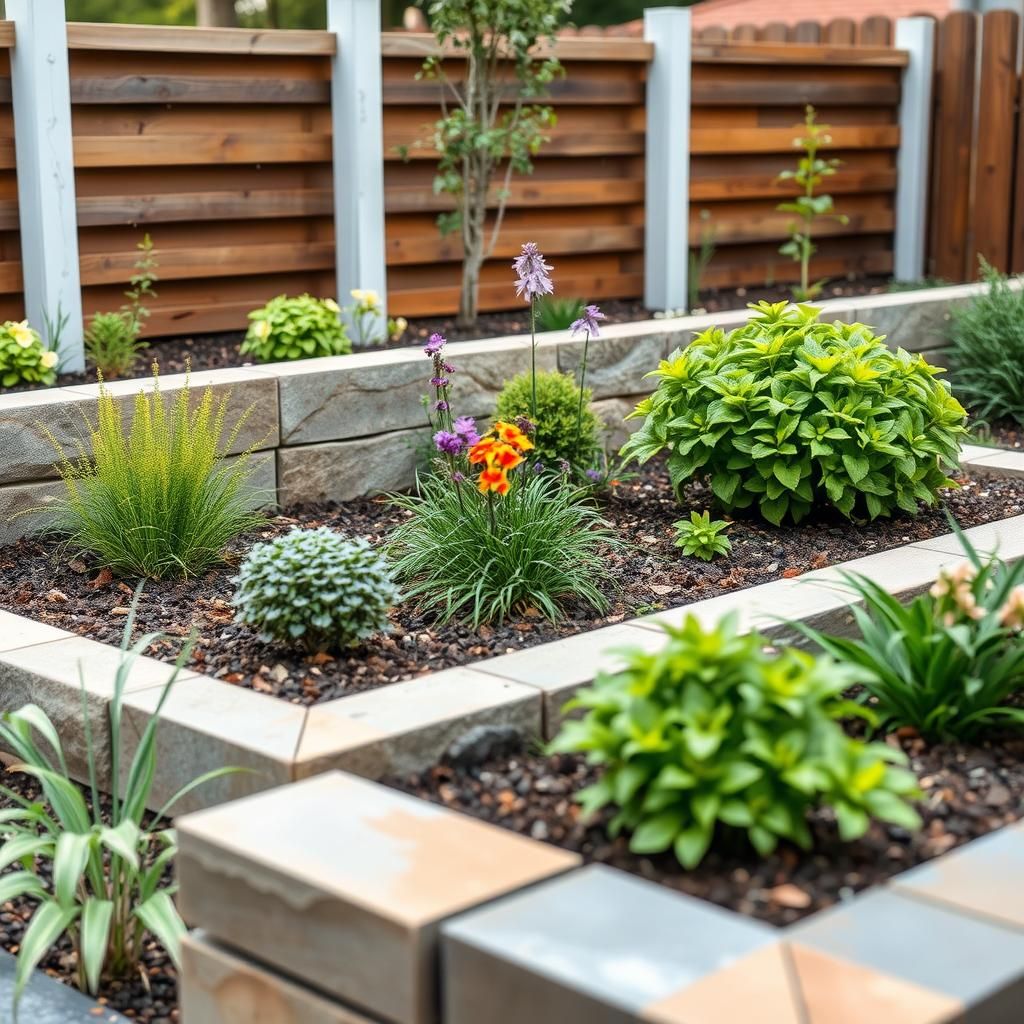Creative and Inspiring Garden Bed Retaining Wall Ideas for Your Outdoor Space

Transforming your outdoor space can be an exciting challenge, and one of the most impactful features you can incorporate is a creative garden bed retaining wall. These structures not only provide necessary support to prevent soil erosion but also serve as a canvas for artistic expression. From rustic stone designs to modern geometric shapes, the possibilities are endless. Whether you have a sprawling backyard or a cozy patio, the right retaining wall can enhance the overall aesthetics of your garden while serving practical purposes. In this article, we will explore various inspiring ideas to elevate your outdoor space with stunning garden bed retaining walls.
Creative Garden Bed Retaining Wall Ideas
Incorporating a retaining wall in your garden bed design can elevate the aesthetic appeal of your outdoor space while providing essential functions such as soil retention and drainage management. There are various materials and styles available, allowing you to create a unique look that complements your landscape. From timber to stone and even bricks, you can explore different textures and finishes to enhance your garden's visual interest. Additionally, consider integrating features like built-in seating or planters into your retaining wall for added practicality and style. Exploring these innovative ideas can help you transform your garden into a visually stunning and functional area.
Materials for Retaining Walls
When choosing materials for your retaining wall, several options can affect both the appearance and functionality. Concrete blocks offer durability and a modern look, while natural stones can create a rustic charm. Timber walls provide a warm, organic feel, especially when using reclaimed wood for a sustainable approach. Bricks offer a classic aesthetic and can be arranged in various patterns for a decorative touch. For a more contemporary garden, modular wall systems allow for versatile design and are easier to install. Each material has its advantages and can be selected based on the overall design theme of your garden.
Layering Techniques for Garden Beds
Layering is a powerful technique to enhance both the functionality and aesthetics of your garden bed. By using a tiered approach, you can create visually appealing microclimates that support a variety of plant species. For instance, placing lower-growing plants at the front and taller ones at the back can create depth. Additionally, using layers of different materials, such as gravel or mulch, can aid in drainage while helping to retain moisture for the roots. Implementing this technique can lead to healthier plants and a more dynamic garden display.
Integrating Seating into the Design
Incorporating seating within your garden bed retaining wall can greatly enhance its usability and charm. Designing a bench or seating ledge as part of the wall not only provides a functional resting area but also invites social interaction within the garden. You can build this into the structure using the same material as the wall for a cohesive look, or consider contrasting materials to create visual interest. Add cushions or decorative pillows for comfort, turning your garden into a welcoming oasis perfect for relaxation or entertaining guests.
Incorporating Planters in Retaining Walls
Adding planters into your retaining wall design offers both practicality and beauty. A combination of structural elements and greenery can create a stunning effect, as the living plants soften the hardscape. You can implement built-in planters at intervals along the wall to introduce flowers, herbs, or even small shrubs that enhance the aesthetic appeal. This not only promotes biodiversity but also provides easy access to plant maintenance without interfering with the wall's main function. Such incorporation encourages a thriving garden that is both functional and visually attractive.
Lighting Considerations for Retaining Walls
Proper lighting around your retaining wall can emphasize its texture and elevate the overall ambiance of the garden. Incorporating built-in lights or uplighting can highlight unique features of the wall, creating stunning shadows at night. Consider using solar-powered lights for an eco-friendly and energy-efficient option. Additionally, placing lights along pathways or seating areas can enhance safety while providing visual flow throughout your space. Thoughtful lighting design can transform your garden into a captivating environment that invites enjoyment even after sunset.
| Material | Durability | Cost | Aesthetic |
|---|---|---|---|
| Concrete Blocks | High | Moderate | Modern |
| Natural Stones | High | High | Rustic |
| Timber | Moderate | Low | Organic |
| Bricks | High | Moderate | Classic |
| Modular Systems | High | Moderate | Contemporary |
What is the cheapest way to build a retaining wall in a garden?

To build a retaining wall in a garden economically, several strategies can be employed to minimize costs while ensuring effectiveness. Below are key elements to consider when seeking the cheapest way to construct a retaining wall:
1. Materials: Choosing the right materials can significantly reduce costs. Utilize locally sourced and inexpensive options such as:
- Natural stone: Often available for minimal cost if sourced from local quarries or landscapes undergoing renovation.
- Concrete blocks: These are relatively cheap and easy to install, requiring minimal tools and skills.
- Wood: Treated lumber can be an economical choice for smaller walls, though it might require maintenance over time.
2. Design: A simple and straightforward design can cut down on expenses. Consider the following design elements:
- Gravity walls: These rely on their weight to hold back soil and do not require complex engineering.
- Tiered walls: Multiple smaller walls can sometimes be cheaper than one large wall, depending on the landscape.
- Integrated landscaping: Incorporating plants into the wall design can reduce the amount of material needed and enhance aesthetics.
3. DIY Installation: Labor costs can greatly affect the budget. Doing it yourself can save significant money. Recommendations include:
- Research: Utilize online resources and tutorials to gather information on the construction process.
- Hire equipment: If heavy lifting is necessary, renting equipment can be more cost-effective than hiring labor.
- Involve friends or family: Enlist help from others to share the workload and make the construction process more efficient.
4. Soil Considerations: The condition and type of soil can impact both the cost and the design of the wall. Tips include:
- Soil testing: Understand the soil type to determine the necessary wall height and thickness, ensuring sufficient strength without overspending.
- Drainage solutions: Incorporate proper drainage to avoid wall failure, which might necessitate additional costs if not addressed initially.
- Gradual slope: Building on a slope may require less material than a vertical wall, thus decreasing costs.
5. Permits and Regulations: Be aware of local laws regarding retaining walls. Steps to take include:
- Check local codes: Understanding permit requirements can prevent fines and additional expenses down the line.
- Consult with neighbors: Discussing your plans with nearby residents can help avoid disputes that might lead to costly changes or demolitions.
- Engage professionals for advice: If unsure, a consultation with a local landscape architect or civil engineer can save money by ensuring correct initial choices.
By focusing on the most cost-effective materials, simplifying design and installation processes, considering soil conditions, and adhering to local regulations, one can build a functional and affordable retaining wall that meets gardening and landscaping needs.
What is the cheapest option for a retaining wall?


The cheapest option for a retaining wall typically involves using basic materials that are readily available and easy to install. One common choice is a wooden retaining wall made from pressure-treated lumber. Another economical option is a boulder wall utilizing natural stones from the area. Concrete blocks or dry-stacked stone walls are also budget-friendly solutions. The overall costs can vary significantly depending on the size, materials, and local labor rates, but here are some commonly affordable options:
Wooden Retaining Walls
Wooden retaining walls are a popular and low-cost option for homeowners. Constructed primarily from pressure-treated lumber, they can effectively hold back soil and are relatively easy to install.
- Cost-effective: Generally the cheapest material available.
- Easy installation: Requires basic tools and skills.
- Natural appearance: Blends well with landscaping.
Concrete Block Walls
Concrete blocks are another economical choice for constructing retaining walls. They provide sturdiness and durability while being relatively low in cost compared to other materials.
- Durable: Can withstand heavy soil pressures.
- Low maintenance: Resists decay and damage over time.
- Versatile design: Available in various sizes and colors.
Boulder Retaining Walls
Boulder walls use large stones gathered from nearby locations, harnessing natural resources for a low-cost solution. They can add a rustic charm to the landscape while providing functionality.
- Natural materials: Reduces costs associated with transportation.
- Eco-friendly: Utilizes locally sourced stones.
- Unique aesthetics: Each wall has a distinct look.
Dry-Stacked Stone Walls
Dry-stacked stone walls involve stacking stones without mortar, creating a structure that is both inexpensive and visually appealing. This method allows for drainage between the stones, reducing water pressure on the wall.
- Cost-efficient: Less labor-intensive due to no mortar.
- Drainage capabilities: Minimizes soil pressure issues.
- Aesthetic appeal: Offers a natural, organic look.
Gabion Walls
Gabion walls consist of wire mesh baskets filled with rocks or rubble, providing an affordable retaining wall option that is also highly effective for erosion control.
- Budget-friendly: Uses inexpensive materials like stones and mesh.
- Strong structure: Offers excellent stability.
- Environmental benefits: Promotes plant growth through drainage.
What is the 1 3 rule for retaining walls?

The 1:3 rule for retaining walls is a guideline used in designing and constructing these structures. It refers specifically to the ratio of the height of the retaining wall to the distance required from the base of the wall to the point of application of the lateral earth pressure. According to this rule, for every 1 unit of height of the wall, there should be 3 units of horizontal distance away from the wall base. This ratio helps in maintaining stability and preventing structural failures due to lateral soil pressures and other loads.
Importance of the 1:3 Rule
The 1:3 rule is crucial for ensuring the stability of retaining walls. By adhering to this guideline, engineers can significantly reduce the risk of failure due to soil movement and water pressure.
- Soil Pressure Management: Properly designing the distance from the wall helps manage the lateral forces exerted by the soil.
- Water Drainage: This rule allows for adequate space for drainage solutions, mitigating hydrostatic pressure behind the wall.
- Structural Integrity: Following the 1:3 ratio contributes to the overall structural integrity, minimizing the likelihood of collapse.
Factors Affecting the 1:3 Rule
While the 1:3 rule provides a solid baseline, several factors can influence its application in specific scenarios.
- Soil Type: The composition and cohesion of the soil can affect the amount of pressure exerted on the wall.
- Wall Material: Different materials (concrete, timber, etc.) have varying strengths that can allow for adjustments to the rule.
- Height of the Wall: For particularly tall walls, additional engineering considerations may be necessary beyond the basic ratio.
Design Considerations
When applying the 1:3 rule, several design factors must be taken into consideration to ensure the successful implementation of a retaining wall.
- Load Bearing Capacity: The wall must be designed to withstand not just the soil pressure, but other loads such as vehicles or structures above it.
- Reinforcement Requirements: Depending on the soil and wall height, additional reinforcement may be needed to maintain stability.
- Aesthetic Design: Beyond functionality, the visual appeal of the wall may influence design choices concerning materials and finishes.
Applications of the 1:3 Rule
The 1:3 rule is not just a theoretical guideline; it has practical applications in various construction scenarios.
- Residential Landscaping: Homeowners often utilize retaining walls for garden beds, terraces, and slopes, ensuring stability and aesthetics.
- Commercial Development: In commercial sites, retaining walls are essential for leveling land and providing safe infrastructure.
- Highway Construction: Engineers apply the 1:3 rule when designing roadways on slopes to prevent landslides and provide safety barriers.
Common Mistakes to Avoid
When implementing the 1:3 rule, various common mistakes can jeopardize the effectiveness of retaining wall designs.
- Ignoring Soil Conditions: Failing to analyze soil conditions properly can lead to wall failure, undermining the rule.
- Neglecting Drainage: Not including adequate drainage solutions may increase hydrostatic pressure, leading to wall movement.
- Improper Material Selection: Using materials that are not suitable for the specific application can weaken the structure over time.
What are the 7 common mistakes made when installing retaining wall blocks?

1. Improper Drainage Solutions
Improper Drainage Solutions
One of the most critical mistakes made when installing retaining wall blocks is neglecting drainage. Proper drainage is essential to reduce the hydrostatic pressure behind the wall. If water is allowed to accumulate, it can lead to instability and failure of the wall. To ensure effective drainage, follow these steps:
See also:
- Install a drainage pipe at the base of the wall to channel water away.
- Backfill with gravel to promote drainage and prevent soil erosion.
- Ensure that the wall has weep holes to allow water to escape.
2. Incorrect Block Alignment
Incorrect Block Alignment
Achieving proper alignment of the wall blocks is crucial for both aesthetics and structural stability. Misaligned blocks can lead to uneven weight distribution and potential collapse. Key factors to maintain correct alignment include:
- Use a level to check that each block is straight both horizontally and vertically.
- Utilize a string line to ensure consistency across the entire wall length.
- Regularly step back and visually inspect the alignment during installation.
3. Neglecting the Base Preparation
Neglecting the Base Preparation
The foundation on which retaining wall blocks are set is often overlooked. A weak or uneven base can compromise the entire structure. To avoid this issue, proper base preparation must be carried out:
- Excavate a trench deep enough to hold a solid base of gravel.
- Compact the base material thoroughly to reduce settling over time.
- Ensure that the base is level to provide stability to the wall.
4. Ignoring Wall Setback Requirements
Ignoring Wall Setback Requirements
Failing to incorporate a setback in the design can cause undue stress on the retaining wall. A wall setback involves tilting the wall back towards the retained soil. Maintaining this degree is essential for durability and safety:
- Determine the appropriate setback, usually 1 inch for every 12 inches in height.
- Mark the setback line before starting the installation for visual guidance.
- Ensure each layer of blocks maintains the required angle as you build up.
5. Using Inappropriate Materials
Using Inappropriate Materials
The use of unsuitable materials can compromise the effectiveness and longevity of a retaining wall. Selecting the right type of blocks and materials is paramount for successful installation. Consider the following factors when choosing materials:
- Opt for heavy-duty blocks that can withstand the pressure of the soil.
- Evaluate compatibility with local climate conditions for durability.
- Incorporate geotextiles as needed to enhance soil stability behind the wall.
6. Not Planning for Expansion and Contraction
Not Planning for Expansion and Contraction
Ignoring the effects of temperature fluctuations can lead to cracks in the retaining wall. It is essential to build in flexibility for expansion and contraction:
- Leave space between blocks to allow for natural movement.
- Use flexible jointing materials to accommodate thermal expansion.
- Regularly inspect the wall for any signs of distress due to seasonal changes.
7. Insufficient Backfill Compaction
Insufficient Backfill Compaction
Finally, failing to compact the backfill adequately can lead to settlement and wall failure. Proper backfill compaction creates stability and minimizes the risk of wall issues. To ensure effective compaction:
- Layer backfill material no more than 6 inches deep before compacting.
- Use a mechanical compactor for optimal density and stability.
- Check the moisture content of the soil to facilitate proper compaction.
Questions from Our Readers
What are some popular materials for garden bed retaining walls?
Common materials for garden bed retaining walls include natural stone, brick, concrete blocks, and wood. Each material offers its own benefits in terms of aesthetic appeal and durability, making it important to choose one that suits both your garden's style and budget.
How high can a garden bed retaining wall be built?
The height of a garden bed retaining wall is generally limited to 4 feet for most residential projects, depending on local regulations and engineering requirements. However, taller walls may require professional planning to ensure stability and safety.
What are some design ideas for garden bed retaining walls?
When designing a garden bed retaining wall, consider incorporating curved shapes, terraced levels, or integrated seating to enhance visual interest. You can also mix materials or add planting pockets to create a more dynamic and appealing landscape.
Do garden bed retaining walls require drainage?
Yes, garden bed retaining walls typically require proper drainage to prevent water buildup that can lead to erosion or structural failure. Incorporating drainage systems or using permeable materials can help manage water while ensuring the longevity of the wall.
See also:

If you want to read more articles like Creative and Inspiring Garden Bed Retaining Wall Ideas for Your Outdoor Space, we recommend you check out our Landscaping category.
Leave a Reply
Related Articles